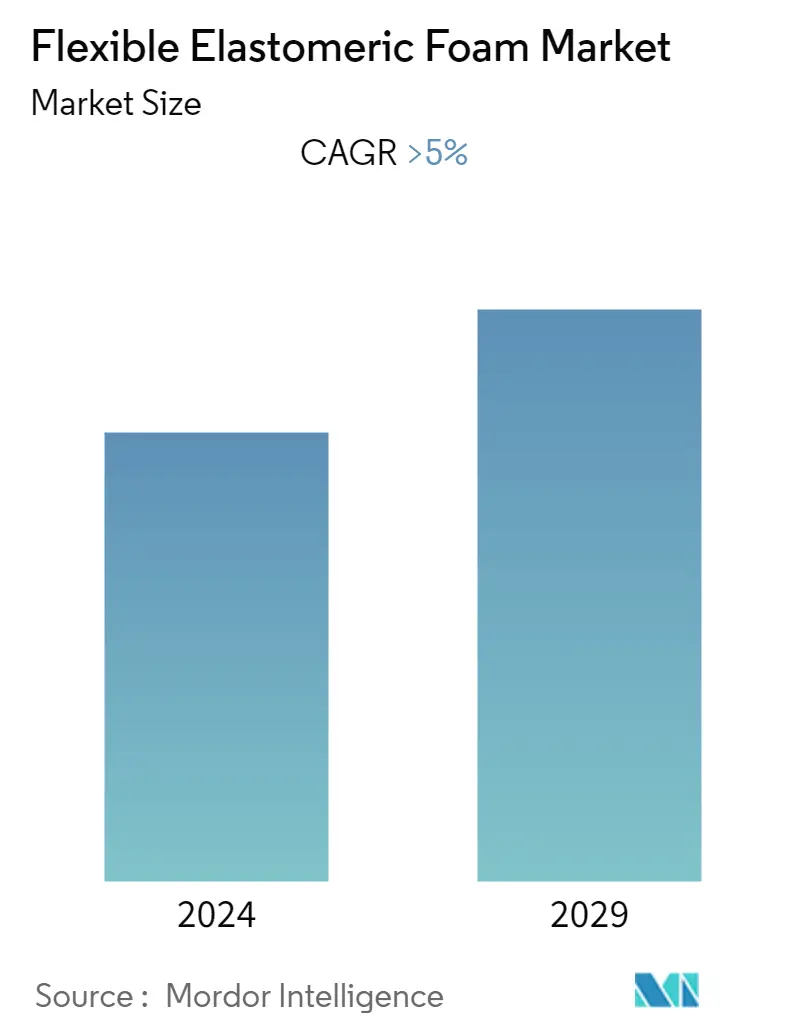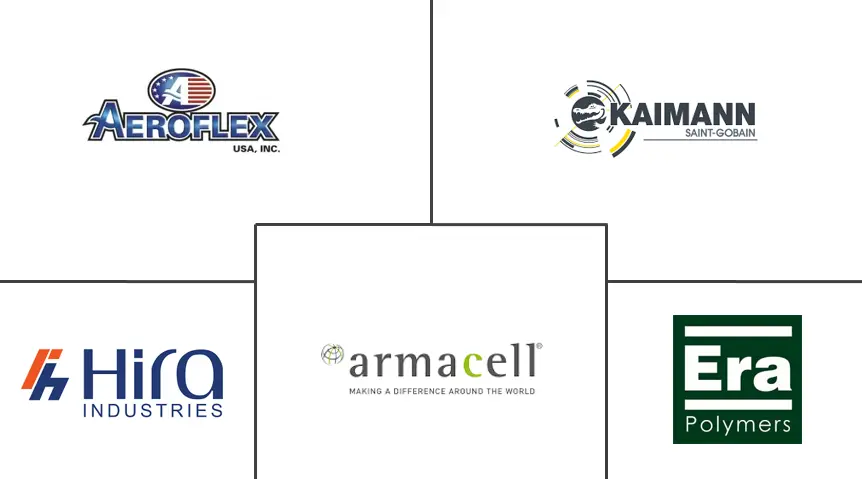Market Size of Flexible Elastomeric Foam Industry

| Study Period | 2019 - 2029 |
| Base Year For Estimation | 2023 |
| CAGR | > 5.00 % |
| Fastest Growing Market | Asia Pacific |
| Largest Market | Asia Pacific |
| Market Concentration | Low |
Major Players
*Disclaimer: Major Players sorted in no particular order |
Flexible Elastomeric Foam Market Analysis
The market is expected to register a CAGR of about 5% during the forecast period. One of the major factors driving the market is the increasing demand for flexible elastomeric foam with growing HVAC systems in major economies of the world. However, lack of awareness about the benefits of insulation using elastomeric foams in the emerging economies is expected to hinder the growth of the market studied.
The growing demand of elastomeric foam in the Healthcare Industry is likely to act as an opportunity for the market studied in the coming years.
By application, demand for flexible elastomeric foam in HVAC systems is expected to grow further during the forecast period.
Asia-Pacific dominated the market globally, with the largest consumption from countries, such as China, Japan, and India.
Flexible Elastomeric Foam Industry Segmentation
The report on flexible elastomeric foam market includes:
| Function | |
| Thermal Insulation | |
| Acoustic Insulation |
| Type | |
| Natural Rubber/Latex | |
| Nitrile Butadiene Rubber/Polyvinyl chloride | |
| Ethylene Propylene Dine Monomer | |
| Chloroprene | |
| Other Types |
| Application | |
| HVAC | |
| Automotive | |
| Transportation | |
| Solar Installations | |
| Refrigeration Systems | |
| Other Applications |
| Geography | |||||||
| |||||||
| |||||||
| |||||||
| |||||||
|
Flexible Elastomeric Foam Market Size Summary
The flexible elastomeric foam market is poised for steady growth, driven primarily by the increasing demand for these materials in HVAC systems across major global economies. This growth is supported by the material's role as an effective barrier against vapor and moisture, making it a preferred choice over traditional insulating materials like cork. The environmental benefits of elastomeric foams, due to their manufacturing process that excludes harmful substances such as HCFCs, CFCs, and HFCs, further enhance their appeal. The rising demand for HVAC equipment, fueled by increased construction activities and higher disposable incomes, is expected to bolster the market. Additionally, the healthcare industry's growing need for elastomeric foam presents new opportunities for market expansion.
Regionally, Asia-Pacific leads the global market, with significant consumption in countries like China, Japan, and India. This region's dominance is attributed to its status as a manufacturing hub for HVAC and cryogenic systems, which drives the demand for flexible elastomeric foam. The presence of major producers in Asia-Pacific, coupled with the region's rapid economic growth and rising per capita income, is expected to sustain its growth trajectory. The market is characterized by a partial consolidation, with a few key players such as Era Polymers Pty Ltd, Armacell, Kaimann GmbH, AEROFLEX USA, INC, and Hira Industries LLC holding significant market shares. As the demand for better thermal and acoustic insulation solutions increases, particularly in developing countries, the flexible elastomeric foam market is projected to experience substantial growth in the coming years.
Flexible Elastomeric Foam Market Size - Table of Contents
-
1. MARKET DYNAMICS
-
1.1 Drivers
-
1.1.1 Increasing Demand for Flexible Elastomeric Foam with Growing HVAC Systems
-
1.1.2 Growing Demand for Flexible Elastomeric Foam from Automotive Industry
-
1.1.3 Other Drivers
-
-
1.2 Restraints
-
1.2.1 Lack of Awareness About the Benefits of Insulation Using Elastomeric foams in the Emerging Economies
-
1.2.2 Other Restraints
-
-
1.3 Industry Value Chain Analysis
-
1.4 Porter's Five Forces Analysis
-
1.4.1 Threat of New Entrants
-
1.4.2 Bargaining Power of Buyers
-
1.4.3 Bargaining Power of Suppliers
-
1.4.4 Threat of Substitute Products
-
1.4.5 Degree of Competition
-
-
-
2. MARKET SEGMENTATION
-
2.1 Function
-
2.1.1 Thermal Insulation
-
2.1.2 Acoustic Insulation
-
-
2.2 Type
-
2.2.1 Natural Rubber/Latex
-
2.2.2 Nitrile Butadiene Rubber/Polyvinyl chloride
-
2.2.3 Ethylene Propylene Dine Monomer
-
2.2.4 Chloroprene
-
2.2.5 Other Types
-
-
2.3 Application
-
2.3.1 HVAC
-
2.3.2 Automotive
-
2.3.3 Transportation
-
2.3.4 Solar Installations
-
2.3.5 Refrigeration Systems
-
2.3.6 Other Applications
-
-
2.4 Geography
-
2.4.1 Asia-Pacific
-
2.4.1.1 China
-
2.4.1.2 India
-
2.4.1.3 Japan
-
2.4.1.4 South Korea
-
2.4.1.5 Rest of Asia-Pacific
-
-
2.4.2 North America
-
2.4.2.1 United States
-
2.4.2.2 Canada
-
2.4.2.3 Mexico
-
-
2.4.3 Europe
-
2.4.3.1 Germany
-
2.4.3.2 United Kingdom
-
2.4.3.3 France
-
2.4.3.4 Italy
-
2.4.3.5 Rest of Europe
-
-
2.4.4 South America
-
2.4.4.1 Brazil
-
2.4.4.2 Argentina
-
2.4.4.3 Rest of South America
-
-
2.4.5 Middle-East and Africa
-
2.4.5.1 Saudi Arabia
-
2.4.5.2 South Africa
-
2.4.5.3 Rest of Middle-East and Africa
-
-
-
Flexible Elastomeric Foam Market Size FAQs
What is the current Flexible Elastomeric Foam Market size?
The Flexible Elastomeric Foam Market is projected to register a CAGR of greater than 5% during the forecast period (2024-2029)
Who are the key players in Flexible Elastomeric Foam Market?
Era Polymers Pty Ltd, Armacell, Kaimann GmbH, AEROFLEX USA, INC and Hira Industries LLC are the major companies operating in the Flexible Elastomeric Foam Market.

